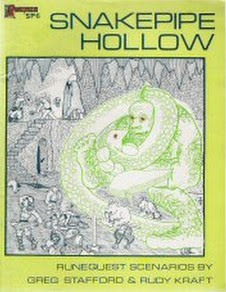Retrospective: Snakepipe Hollow
 The modern roleplaying game was born in the dungeon and the earliest RPG campaigns revolved around exploring them.
The modern roleplaying game was born in the dungeon and the earliest RPG campaigns revolved around exploring them.
For those of us interested in the history of the hobby, it's therefore something of a tragedy that none of those "tent pole" dungeons, like Castles Blackmoor or Greyhawk, ever properly saw print. Instead, what we got were smaller, more focused dungeons intended for limited use (which makes sense, since, in most cases, they originated in the nascent tournament scene). While many of these published dungeons are excellent and indeed iconic, very few of them are suitable for long-term play, particularly when compared to the founding dungeons of the hobby.
I mention all of this because I've lately been doing a deep dive into the early years of Chaosium's RuneQuest, with an eye toward trying to put my finger on why I much prefer its portrayal of Glorantha to that of contemporary RQ. An important piece of that puzzle lies in Snakepipe Hollow, a collection of adventures written by Greg Stafford and Rudy Kraft and first published in 1979. Its title refers to a region of Dragon Pass that's home to the three levels of the Caves of Chaos (no, not those Caves of Chaos, even though they also first appeared in 1979), inhabited by all manner of inimical beings, such as ogres, scorpion men, and broos, among many more.
At the start of the book, Greg Stafford pens a remarkable introduction, in which he explains the origins and purpose of both Snakepipe Hollow the product and Snakepipe Hollow the place within Glorantha. For that reason, I'm going to reproduce it in full here:
This scenario pack provides a setting, motivation, and cast of friendly and hostile characters for the referee needing or desiring to construct a RuneQuest adventure on short notice, or for the readers interested in Dragon Pass as a place for active fantasy.
This book presents a unique section of Dragon Pass geography in some detail. This form presents this material in the same way as we prepared and ran it in our own campaign; we believe it will fit well into many different FRP campaigns.
There are several scenario suggestions, including appropriate NPC (non-player character) stats, which offer opportunities for people to enter this wild and dangerous region. These may take them to a part or all of the sections here. Referees are urged to make up their own as well.
The scenarios are not specifically designed for any number or quality of player characters. However, due to the nature of the region, we suggest that there be a good healthy mix of types, with parties numbering six to ten player characters with NPCs tossed in to provide play balance where necessary.
This pack is designed for repeated play. It contains one wilderness and three interior maps, almost 200 monster stats and over 25,000 words of description presented in a modular and flexible format.
GOOD LUCK!
There are two points that stand out to me. First, Stafford states clearly that the material in Snakepipe Hollow derives from his home campaign and that it's presented "in the same way as we prepared and ran it." I take that to mean that it's not been notably altered from what he used with his own players. Second, he emphasizes that "this pack is designed for repeated play." Thus, this is not a one-and-done product, but instead something that's able to hold the players' attentions for an extended period of time.
Viewed from a certain perspective, Snakepipe Hollow starts to sound, to me at any rate, as if it's another example of an early tent pole dungeon. I won't go so far as to call it a megadungeon, since there are fewer than 60 keyed locations within the Caves of Chaos. Further, I don't believe that a dungeon need be "mega" in extent to qualify as a long-term campaign focus, but that's a topic for another post. Nevertheless, I think a reasonably good case could be made that Snakepipe Hollow possesses the level of depth and complexity needed to occupy the center of an entire campaign, especially when one remembers that the Caves of Chaos sit within a larger wilderness area that is every bit as treacherous – and rewarding – as they are.
If I could refer to Stafford's introduction just one more time, I'd like to note that he calls Snakepipe Hollow a "scenario pack." That's yet another bit of evidence in support of the idea that the Caves of Chaos and the area around it was imagined not just "as a place for active fantasy" – what an evocative turn of phrase! – but as the focus of weeks or months of regular play. In addition to keys for the wilderness and the Caves, Snakepipe Hollow presents multiple potential NPC patrons, groups, rumors, and "help wanted" notices, all of which provide the player characters with reasons for venturing into the Hollow beyond mere treasure hunting. This is not just useful; it's vital, since it'll help frame the characters' expeditions within the context of the larger world, which is exactly what's needed to keep a campaign humming along indefinitely.
Since I was never a player of RuneQuest back in my youth, Snakepipe Hollow is, frankly, revelatory in the way it suggests that the hobby's early emphasis on tent pole dungeons was still alive and well, even in California. More significant still is that the Caves of Chaos and their surrounds may be one of the few published examples of those early campaign dungeons. If so, I think Snakepipe Hollow needs to be more widely known and studied than it seems to be. I know I'll be spending a lot more time with it in the weeks to come.
James Maliszewski's Blog
- James Maliszewski's profile
- 3 followers



